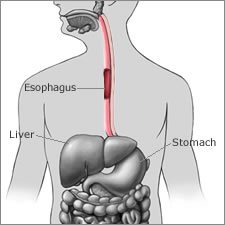Barrett’s Esophagus

Barrett’s esophagus is a condition that affects the lower portion of the esophagus which is the tube connecting the mouth to the stomach. Barrett’s esophagus affects about one percent of adults in the United States and is twice as common in men as in women.
The exact cause of Barrett’s esophagus is unknown, but prolonged exposure of the esophagus to stomach acid is a known risk factor. This is more likely to occur in people who have severe reflux disease (Gastroesophageal Reflux Disease or GERD) where stomach acid leaks backward from the stomach into the esophagus. After prolonged exposure to the stomach acid, the cells of the esophagus change appearance and look like the cells that line the intestines.
Although rare, people with Barrett’s esophagus have an increased risk of developing esophageal cancer.
Symptoms
People with Barrett’s esophagus do not experience any symptoms of the disease. If the disease is caused by GERD, the patient may experience symptoms of reflux such as:
- Frequent heartburn
- Difficulty swallowing food
- Chest pain
- Upper abdominal pain
- Dry cough
Diagnosis
To diagnose Barrett’s esophagus your gastroenterologist will conduct an endoscopic exam. An endoscope is a thin tube with a video camera in it that can be passed through your mouth into your esophagus and stomach.
The endoscopic exam will allow your gastroenterologist to closely examine your esophagus to detect any developing abnormalities or signs of damage, as well as taking a biopsy or tissue sample for further evaluation.
Following the endoscopic exam, your physician will be able to determine the level of cell abnormality that has developed in your esophagus. This is also referred to as the level of dysplasia. The type of dysplasia detected helps your physician to determine the best treatment method.
Treatment
If Barrett’s esophagus is identified during the endoscopy, then there are several treatment options available. In some cases, when no precancerous cells are identified, treating the underlying cause such as GERD is sufficient. Where cell changes (high-grade dysplasia) that are likely to lead to cancer are identified, surgical treatments using laser or other high energy methods to destroy precancerous cells may be recommended.


